University Nursing Case Study: Liver Cirrhosis Patient Care
VerifiedAdded on 2020/03/16
|9
|2535
|44
Case Study
AI Summary
This nursing case study examines a patient, Nathan, diagnosed with alcoholic liver cirrhosis, exploring the causes, incidence, and risk factors associated with the disease, including alcohol consumption and smoking. It delves into the impact of liver cirrhosis on both the patient and their family, highlighting financial burdens and psychological effects. The study identifies common signs and symptoms such as loss of appetite, bruising, weight loss, ascites, and loss of brain function. It outlines two common drug classes, Glucocorticosteroids and Pentoxifylline, used in treatment, discussing their mechanisms and potential complications. Furthermore, the case study details nursing care strategies within the first 24 hours, emphasizing assessment, diagnosis, goal setting, and interventions like promoting rest, nutritional support, skin care, and psychological support, aiming to provide comprehensive patient care and improve outcomes.
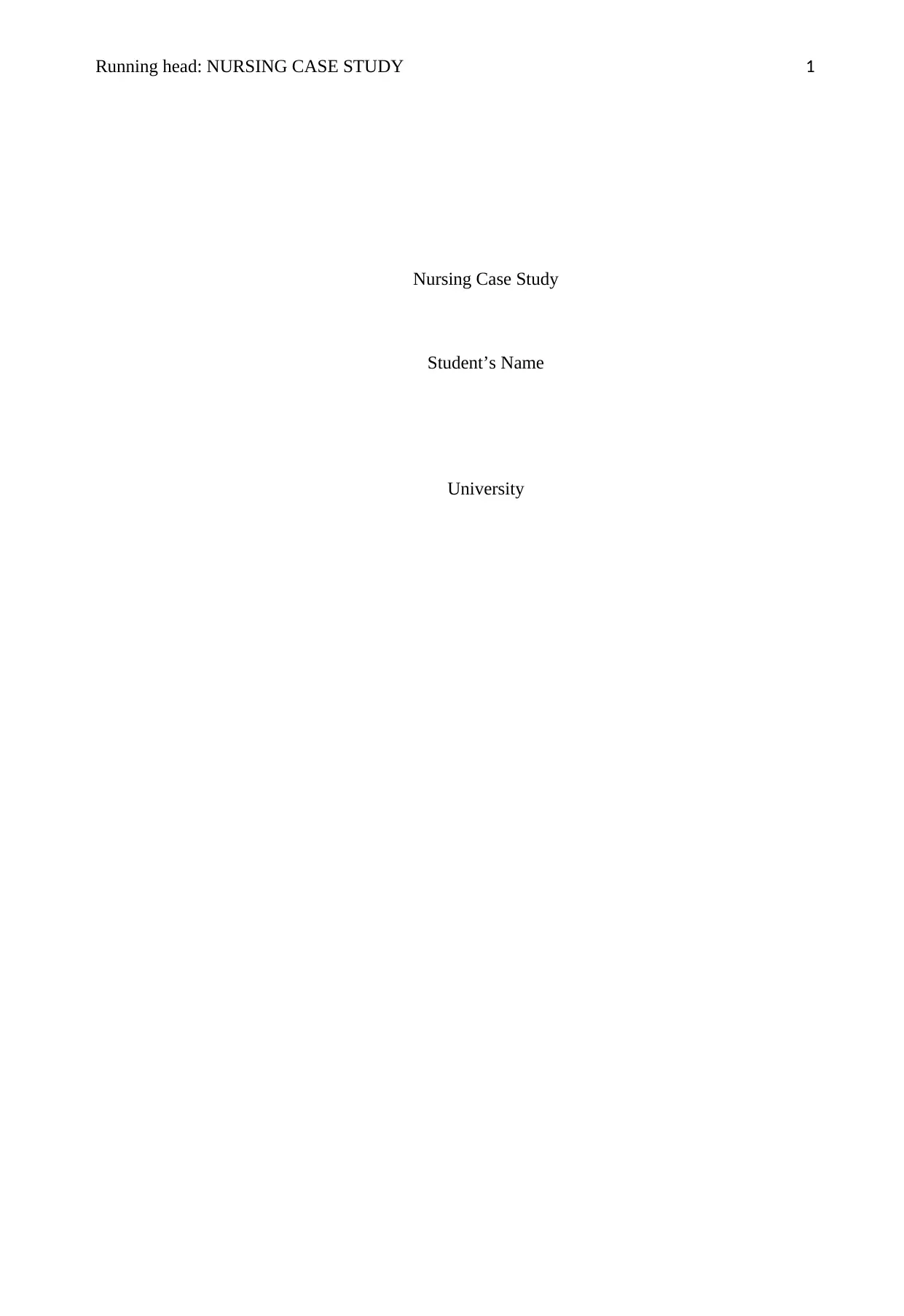
Running head: NURSING CASE STUDY 1
Nursing Case Study
Student’s Name
University
Nursing Case Study
Student’s Name
University
Paraphrase This Document
Need a fresh take? Get an instant paraphrase of this document with our AI Paraphraser
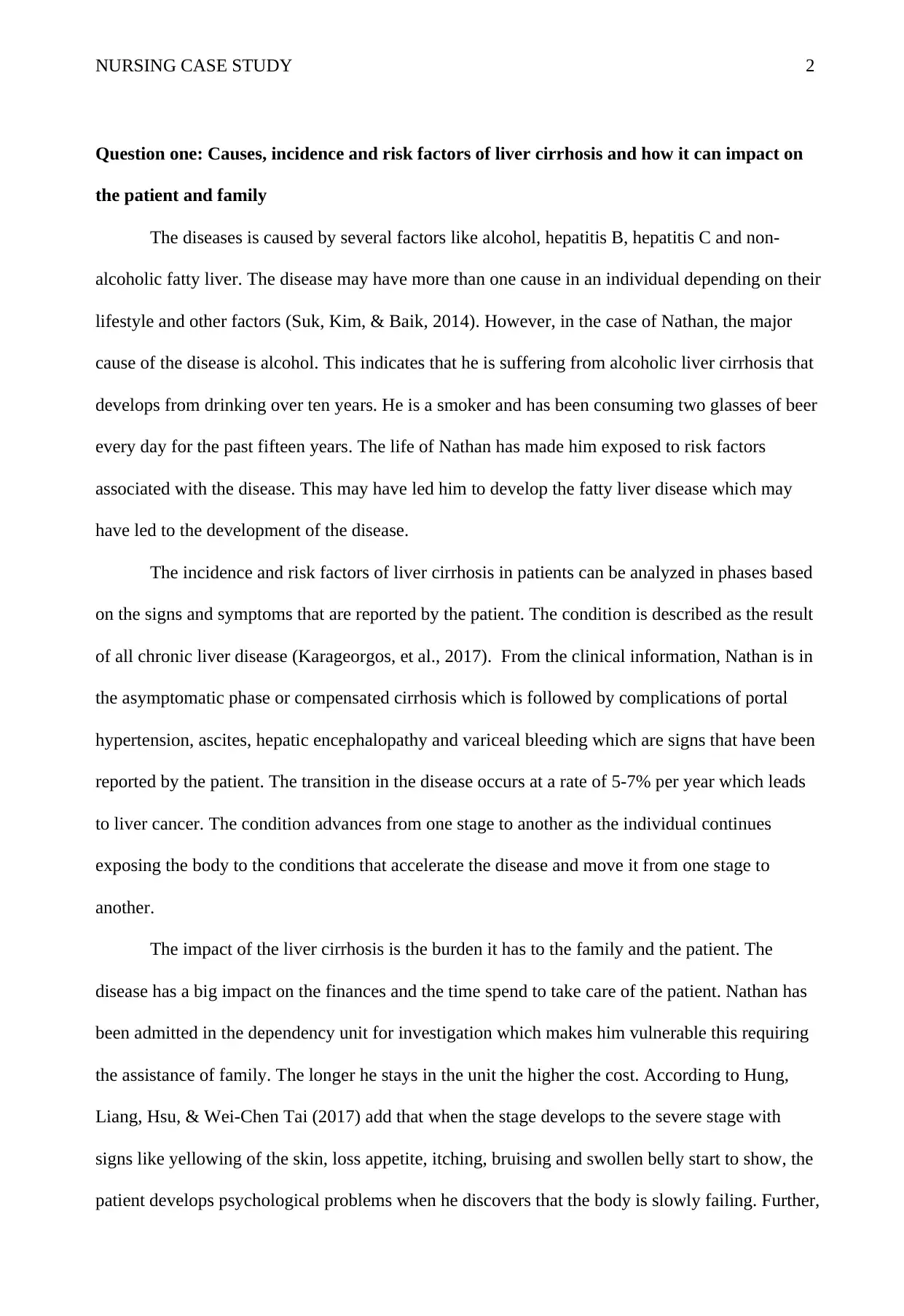
NURSING CASE STUDY 2
Question one: Causes, incidence and risk factors of liver cirrhosis and how it can impact on
the patient and family
The diseases is caused by several factors like alcohol, hepatitis B, hepatitis C and non-
alcoholic fatty liver. The disease may have more than one cause in an individual depending on their
lifestyle and other factors (Suk, Kim, & Baik, 2014). However, in the case of Nathan, the major
cause of the disease is alcohol. This indicates that he is suffering from alcoholic liver cirrhosis that
develops from drinking over ten years. He is a smoker and has been consuming two glasses of beer
every day for the past fifteen years. The life of Nathan has made him exposed to risk factors
associated with the disease. This may have led him to develop the fatty liver disease which may
have led to the development of the disease.
The incidence and risk factors of liver cirrhosis in patients can be analyzed in phases based
on the signs and symptoms that are reported by the patient. The condition is described as the result
of all chronic liver disease (Karageorgos, et al., 2017). From the clinical information, Nathan is in
the asymptomatic phase or compensated cirrhosis which is followed by complications of portal
hypertension, ascites, hepatic encephalopathy and variceal bleeding which are signs that have been
reported by the patient. The transition in the disease occurs at a rate of 5-7% per year which leads
to liver cancer. The condition advances from one stage to another as the individual continues
exposing the body to the conditions that accelerate the disease and move it from one stage to
another.
The impact of the liver cirrhosis is the burden it has to the family and the patient. The
disease has a big impact on the finances and the time spend to take care of the patient. Nathan has
been admitted in the dependency unit for investigation which makes him vulnerable this requiring
the assistance of family. The longer he stays in the unit the higher the cost. According to Hung,
Liang, Hsu, & Wei-Chen Tai (2017) add that when the stage develops to the severe stage with
signs like yellowing of the skin, loss appetite, itching, bruising and swollen belly start to show, the
patient develops psychological problems when he discovers that the body is slowly failing. Further,
Question one: Causes, incidence and risk factors of liver cirrhosis and how it can impact on
the patient and family
The diseases is caused by several factors like alcohol, hepatitis B, hepatitis C and non-
alcoholic fatty liver. The disease may have more than one cause in an individual depending on their
lifestyle and other factors (Suk, Kim, & Baik, 2014). However, in the case of Nathan, the major
cause of the disease is alcohol. This indicates that he is suffering from alcoholic liver cirrhosis that
develops from drinking over ten years. He is a smoker and has been consuming two glasses of beer
every day for the past fifteen years. The life of Nathan has made him exposed to risk factors
associated with the disease. This may have led him to develop the fatty liver disease which may
have led to the development of the disease.
The incidence and risk factors of liver cirrhosis in patients can be analyzed in phases based
on the signs and symptoms that are reported by the patient. The condition is described as the result
of all chronic liver disease (Karageorgos, et al., 2017). From the clinical information, Nathan is in
the asymptomatic phase or compensated cirrhosis which is followed by complications of portal
hypertension, ascites, hepatic encephalopathy and variceal bleeding which are signs that have been
reported by the patient. The transition in the disease occurs at a rate of 5-7% per year which leads
to liver cancer. The condition advances from one stage to another as the individual continues
exposing the body to the conditions that accelerate the disease and move it from one stage to
another.
The impact of the liver cirrhosis is the burden it has to the family and the patient. The
disease has a big impact on the finances and the time spend to take care of the patient. Nathan has
been admitted in the dependency unit for investigation which makes him vulnerable this requiring
the assistance of family. The longer he stays in the unit the higher the cost. According to Hung,
Liang, Hsu, & Wei-Chen Tai (2017) add that when the stage develops to the severe stage with
signs like yellowing of the skin, loss appetite, itching, bruising and swollen belly start to show, the
patient develops psychological problems when he discovers that the body is slowly failing. Further,
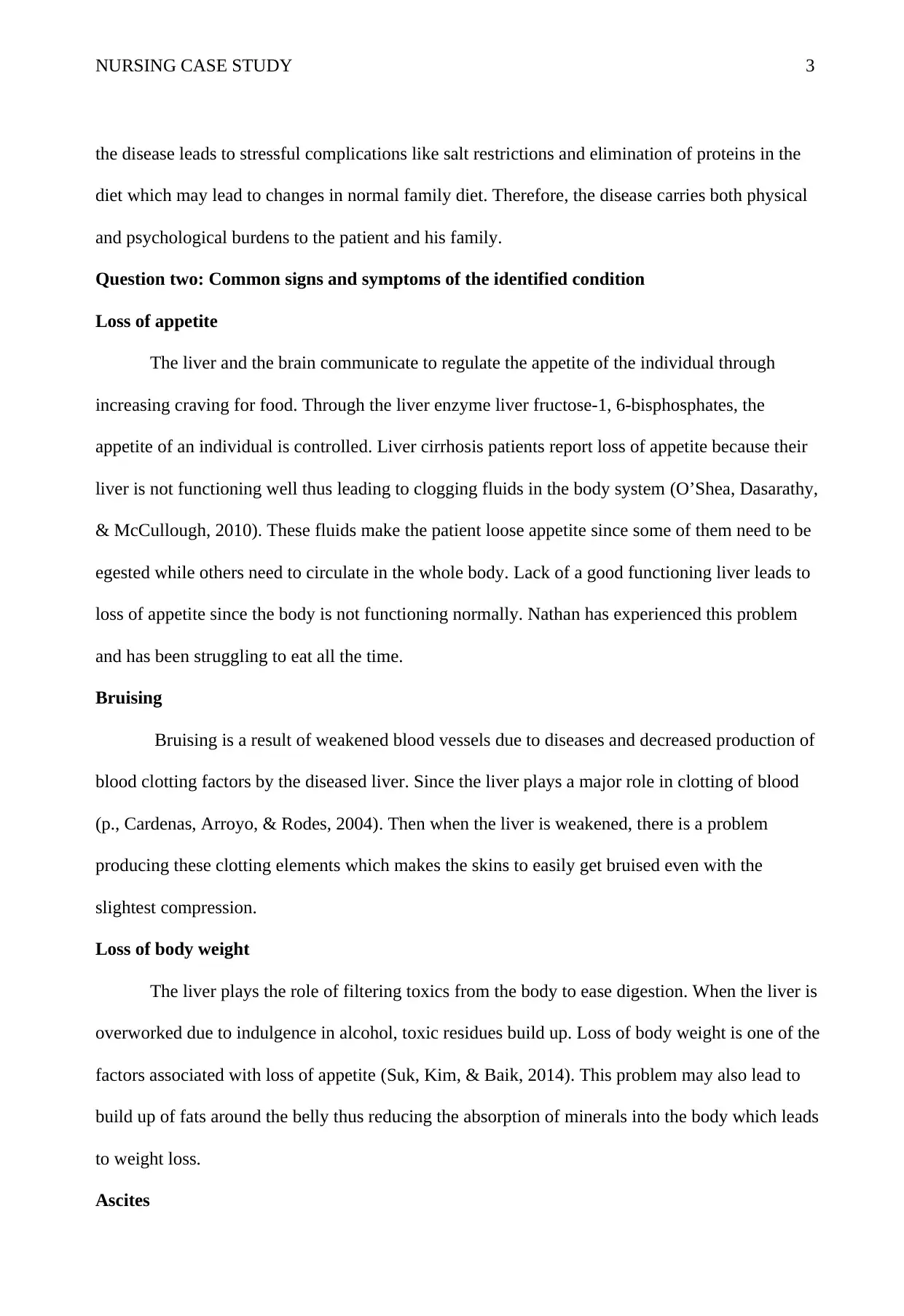
NURSING CASE STUDY 3
the disease leads to stressful complications like salt restrictions and elimination of proteins in the
diet which may lead to changes in normal family diet. Therefore, the disease carries both physical
and psychological burdens to the patient and his family.
Question two: Common signs and symptoms of the identified condition
Loss of appetite
The liver and the brain communicate to regulate the appetite of the individual through
increasing craving for food. Through the liver enzyme liver fructose-1, 6-bisphosphates, the
appetite of an individual is controlled. Liver cirrhosis patients report loss of appetite because their
liver is not functioning well thus leading to clogging fluids in the body system (O’Shea, Dasarathy,
& McCullough, 2010). These fluids make the patient loose appetite since some of them need to be
egested while others need to circulate in the whole body. Lack of a good functioning liver leads to
loss of appetite since the body is not functioning normally. Nathan has experienced this problem
and has been struggling to eat all the time.
Bruising
Bruising is a result of weakened blood vessels due to diseases and decreased production of
blood clotting factors by the diseased liver. Since the liver plays a major role in clotting of blood
(p., Cardenas, Arroyo, & Rodes, 2004). Then when the liver is weakened, there is a problem
producing these clotting elements which makes the skins to easily get bruised even with the
slightest compression.
Loss of body weight
The liver plays the role of filtering toxics from the body to ease digestion. When the liver is
overworked due to indulgence in alcohol, toxic residues build up. Loss of body weight is one of the
factors associated with loss of appetite (Suk, Kim, & Baik, 2014). This problem may also lead to
build up of fats around the belly thus reducing the absorption of minerals into the body which leads
to weight loss.
Ascites
the disease leads to stressful complications like salt restrictions and elimination of proteins in the
diet which may lead to changes in normal family diet. Therefore, the disease carries both physical
and psychological burdens to the patient and his family.
Question two: Common signs and symptoms of the identified condition
Loss of appetite
The liver and the brain communicate to regulate the appetite of the individual through
increasing craving for food. Through the liver enzyme liver fructose-1, 6-bisphosphates, the
appetite of an individual is controlled. Liver cirrhosis patients report loss of appetite because their
liver is not functioning well thus leading to clogging fluids in the body system (O’Shea, Dasarathy,
& McCullough, 2010). These fluids make the patient loose appetite since some of them need to be
egested while others need to circulate in the whole body. Lack of a good functioning liver leads to
loss of appetite since the body is not functioning normally. Nathan has experienced this problem
and has been struggling to eat all the time.
Bruising
Bruising is a result of weakened blood vessels due to diseases and decreased production of
blood clotting factors by the diseased liver. Since the liver plays a major role in clotting of blood
(p., Cardenas, Arroyo, & Rodes, 2004). Then when the liver is weakened, there is a problem
producing these clotting elements which makes the skins to easily get bruised even with the
slightest compression.
Loss of body weight
The liver plays the role of filtering toxics from the body to ease digestion. When the liver is
overworked due to indulgence in alcohol, toxic residues build up. Loss of body weight is one of the
factors associated with loss of appetite (Suk, Kim, & Baik, 2014). This problem may also lead to
build up of fats around the belly thus reducing the absorption of minerals into the body which leads
to weight loss.
Ascites
⊘ This is a preview!⊘
Do you want full access?
Subscribe today to unlock all pages.

Trusted by 1+ million students worldwide
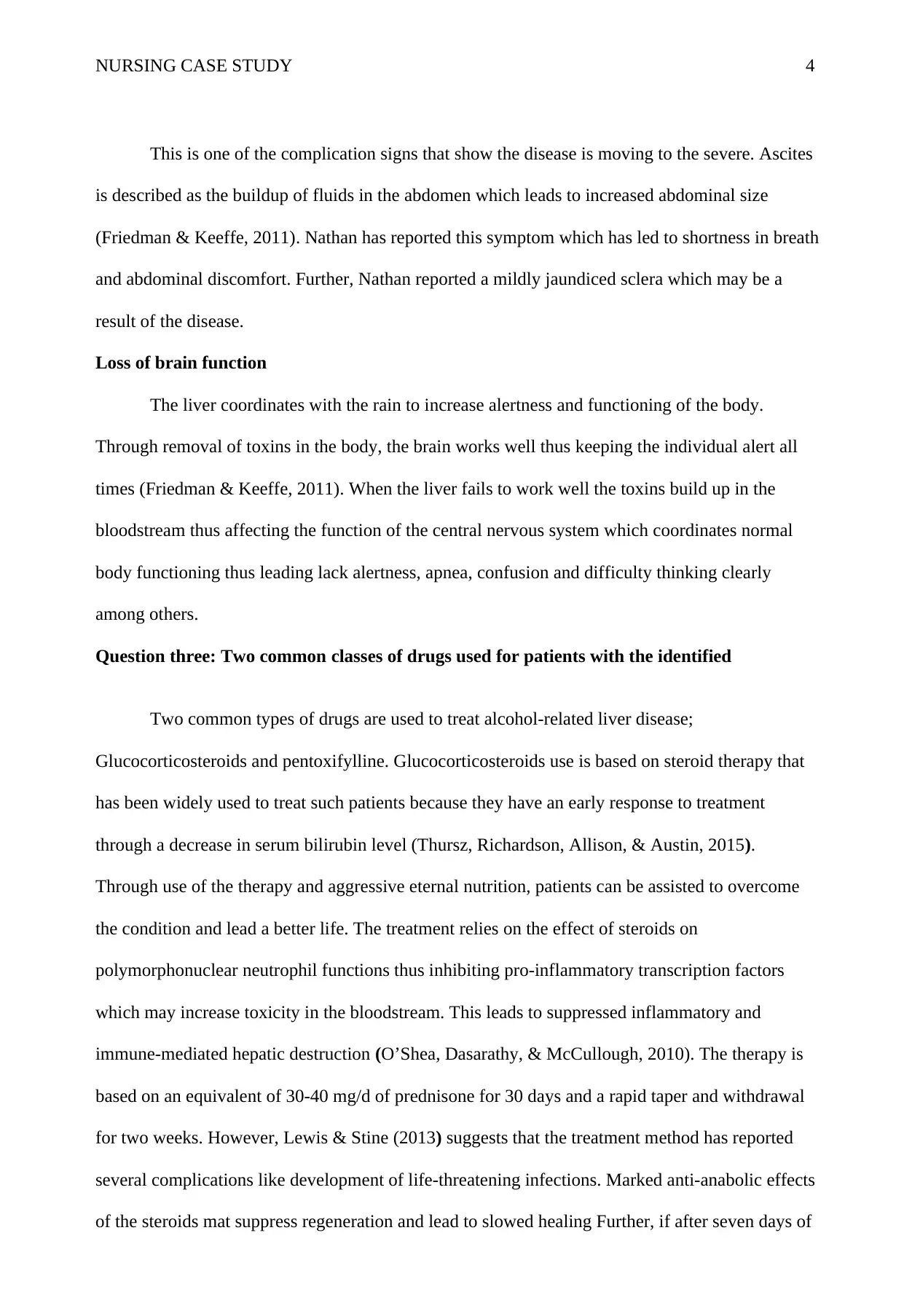
NURSING CASE STUDY 4
This is one of the complication signs that show the disease is moving to the severe. Ascites
is described as the buildup of fluids in the abdomen which leads to increased abdominal size
(Friedman & Keeffe, 2011). Nathan has reported this symptom which has led to shortness in breath
and abdominal discomfort. Further, Nathan reported a mildly jaundiced sclera which may be a
result of the disease.
Loss of brain function
The liver coordinates with the rain to increase alertness and functioning of the body.
Through removal of toxins in the body, the brain works well thus keeping the individual alert all
times (Friedman & Keeffe, 2011). When the liver fails to work well the toxins build up in the
bloodstream thus affecting the function of the central nervous system which coordinates normal
body functioning thus leading lack alertness, apnea, confusion and difficulty thinking clearly
among others.
Question three: Two common classes of drugs used for patients with the identified
Two common types of drugs are used to treat alcohol-related liver disease;
Glucocorticosteroids and pentoxifylline. Glucocorticosteroids use is based on steroid therapy that
has been widely used to treat such patients because they have an early response to treatment
through a decrease in serum bilirubin level (Thursz, Richardson, Allison, & Austin, 2015).
Through use of the therapy and aggressive eternal nutrition, patients can be assisted to overcome
the condition and lead a better life. The treatment relies on the effect of steroids on
polymorphonuclear neutrophil functions thus inhibiting pro-inflammatory transcription factors
which may increase toxicity in the bloodstream. This leads to suppressed inflammatory and
immune-mediated hepatic destruction (O’Shea, Dasarathy, & McCullough, 2010). The therapy is
based on an equivalent of 30-40 mg/d of prednisone for 30 days and a rapid taper and withdrawal
for two weeks. However, Lewis & Stine (2013) suggests that the treatment method has reported
several complications like development of life-threatening infections. Marked anti-anabolic effects
of the steroids mat suppress regeneration and lead to slowed healing Further, if after seven days of
This is one of the complication signs that show the disease is moving to the severe. Ascites
is described as the buildup of fluids in the abdomen which leads to increased abdominal size
(Friedman & Keeffe, 2011). Nathan has reported this symptom which has led to shortness in breath
and abdominal discomfort. Further, Nathan reported a mildly jaundiced sclera which may be a
result of the disease.
Loss of brain function
The liver coordinates with the rain to increase alertness and functioning of the body.
Through removal of toxins in the body, the brain works well thus keeping the individual alert all
times (Friedman & Keeffe, 2011). When the liver fails to work well the toxins build up in the
bloodstream thus affecting the function of the central nervous system which coordinates normal
body functioning thus leading lack alertness, apnea, confusion and difficulty thinking clearly
among others.
Question three: Two common classes of drugs used for patients with the identified
Two common types of drugs are used to treat alcohol-related liver disease;
Glucocorticosteroids and pentoxifylline. Glucocorticosteroids use is based on steroid therapy that
has been widely used to treat such patients because they have an early response to treatment
through a decrease in serum bilirubin level (Thursz, Richardson, Allison, & Austin, 2015).
Through use of the therapy and aggressive eternal nutrition, patients can be assisted to overcome
the condition and lead a better life. The treatment relies on the effect of steroids on
polymorphonuclear neutrophil functions thus inhibiting pro-inflammatory transcription factors
which may increase toxicity in the bloodstream. This leads to suppressed inflammatory and
immune-mediated hepatic destruction (O’Shea, Dasarathy, & McCullough, 2010). The therapy is
based on an equivalent of 30-40 mg/d of prednisone for 30 days and a rapid taper and withdrawal
for two weeks. However, Lewis & Stine (2013) suggests that the treatment method has reported
several complications like development of life-threatening infections. Marked anti-anabolic effects
of the steroids mat suppress regeneration and lead to slowed healing Further, if after seven days of
Paraphrase This Document
Need a fresh take? Get an instant paraphrase of this document with our AI Paraphraser
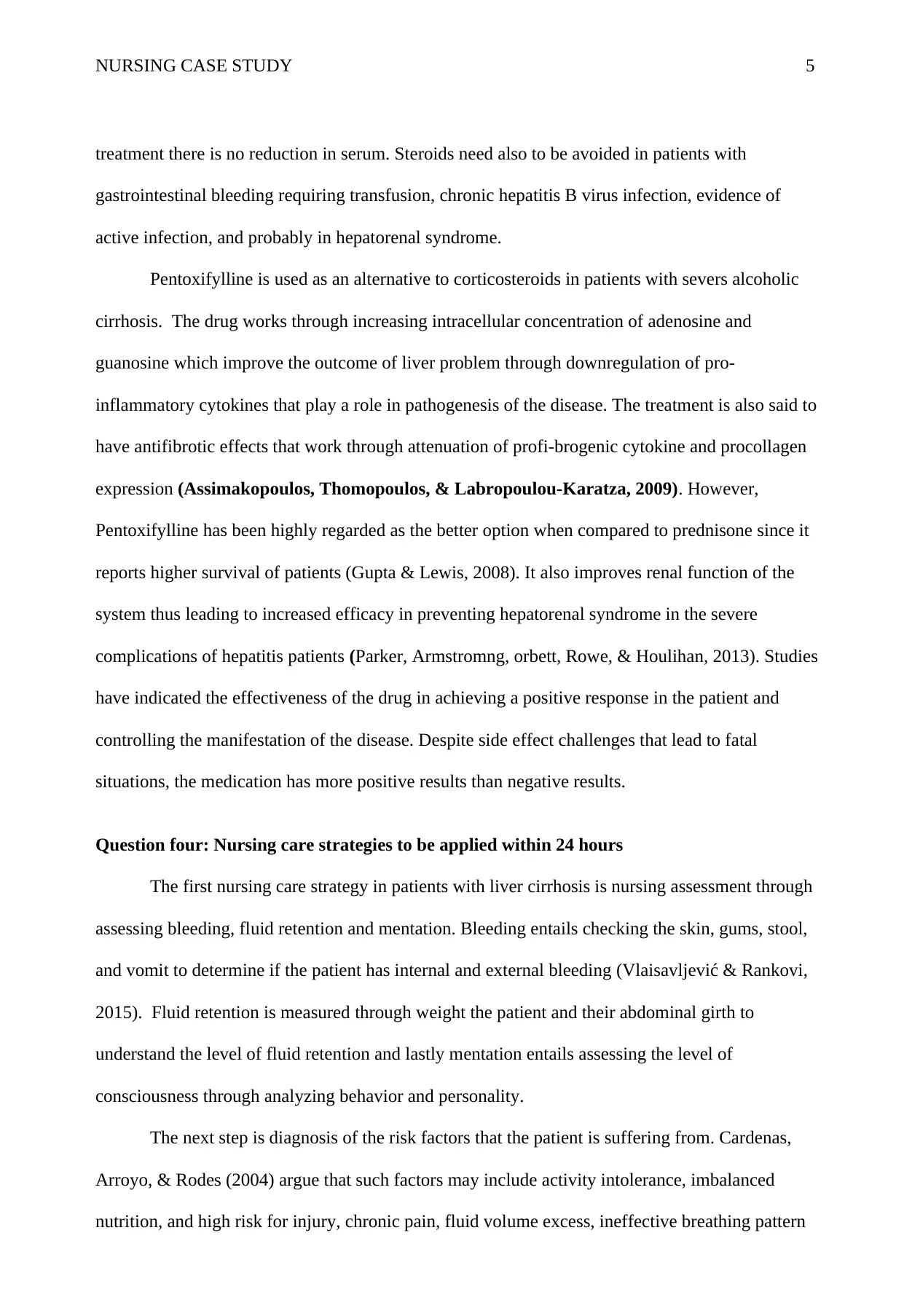
NURSING CASE STUDY 5
treatment there is no reduction in serum. Steroids need also to be avoided in patients with
gastrointestinal bleeding requiring transfusion, chronic hepatitis B virus infection, evidence of
active infection, and probably in hepatorenal syndrome.
Pentoxifylline is used as an alternative to corticosteroids in patients with severs alcoholic
cirrhosis. The drug works through increasing intracellular concentration of adenosine and
guanosine which improve the outcome of liver problem through downregulation of pro-
inflammatory cytokines that play a role in pathogenesis of the disease. The treatment is also said to
have antifibrotic effects that work through attenuation of profi-brogenic cytokine and procollagen
expression (Assimakopoulos, Thomopoulos, & Labropoulou-Karatza, 2009). However,
Pentoxifylline has been highly regarded as the better option when compared to prednisone since it
reports higher survival of patients (Gupta & Lewis, 2008). It also improves renal function of the
system thus leading to increased efficacy in preventing hepatorenal syndrome in the severe
complications of hepatitis patients (Parker, Armstromng, orbett, Rowe, & Houlihan, 2013). Studies
have indicated the effectiveness of the drug in achieving a positive response in the patient and
controlling the manifestation of the disease. Despite side effect challenges that lead to fatal
situations, the medication has more positive results than negative results.
Question four: Nursing care strategies to be applied within 24 hours
The first nursing care strategy in patients with liver cirrhosis is nursing assessment through
assessing bleeding, fluid retention and mentation. Bleeding entails checking the skin, gums, stool,
and vomit to determine if the patient has internal and external bleeding (Vlaisavljević & Rankovi,
2015). Fluid retention is measured through weight the patient and their abdominal girth to
understand the level of fluid retention and lastly mentation entails assessing the level of
consciousness through analyzing behavior and personality.
The next step is diagnosis of the risk factors that the patient is suffering from. Cardenas,
Arroyo, & Rodes (2004) argue that such factors may include activity intolerance, imbalanced
nutrition, and high risk for injury, chronic pain, fluid volume excess, ineffective breathing pattern
treatment there is no reduction in serum. Steroids need also to be avoided in patients with
gastrointestinal bleeding requiring transfusion, chronic hepatitis B virus infection, evidence of
active infection, and probably in hepatorenal syndrome.
Pentoxifylline is used as an alternative to corticosteroids in patients with severs alcoholic
cirrhosis. The drug works through increasing intracellular concentration of adenosine and
guanosine which improve the outcome of liver problem through downregulation of pro-
inflammatory cytokines that play a role in pathogenesis of the disease. The treatment is also said to
have antifibrotic effects that work through attenuation of profi-brogenic cytokine and procollagen
expression (Assimakopoulos, Thomopoulos, & Labropoulou-Karatza, 2009). However,
Pentoxifylline has been highly regarded as the better option when compared to prednisone since it
reports higher survival of patients (Gupta & Lewis, 2008). It also improves renal function of the
system thus leading to increased efficacy in preventing hepatorenal syndrome in the severe
complications of hepatitis patients (Parker, Armstromng, orbett, Rowe, & Houlihan, 2013). Studies
have indicated the effectiveness of the drug in achieving a positive response in the patient and
controlling the manifestation of the disease. Despite side effect challenges that lead to fatal
situations, the medication has more positive results than negative results.
Question four: Nursing care strategies to be applied within 24 hours
The first nursing care strategy in patients with liver cirrhosis is nursing assessment through
assessing bleeding, fluid retention and mentation. Bleeding entails checking the skin, gums, stool,
and vomit to determine if the patient has internal and external bleeding (Vlaisavljević & Rankovi,
2015). Fluid retention is measured through weight the patient and their abdominal girth to
understand the level of fluid retention and lastly mentation entails assessing the level of
consciousness through analyzing behavior and personality.
The next step is diagnosis of the risk factors that the patient is suffering from. Cardenas,
Arroyo, & Rodes (2004) argue that such factors may include activity intolerance, imbalanced
nutrition, and high risk for injury, chronic pain, fluid volume excess, ineffective breathing pattern
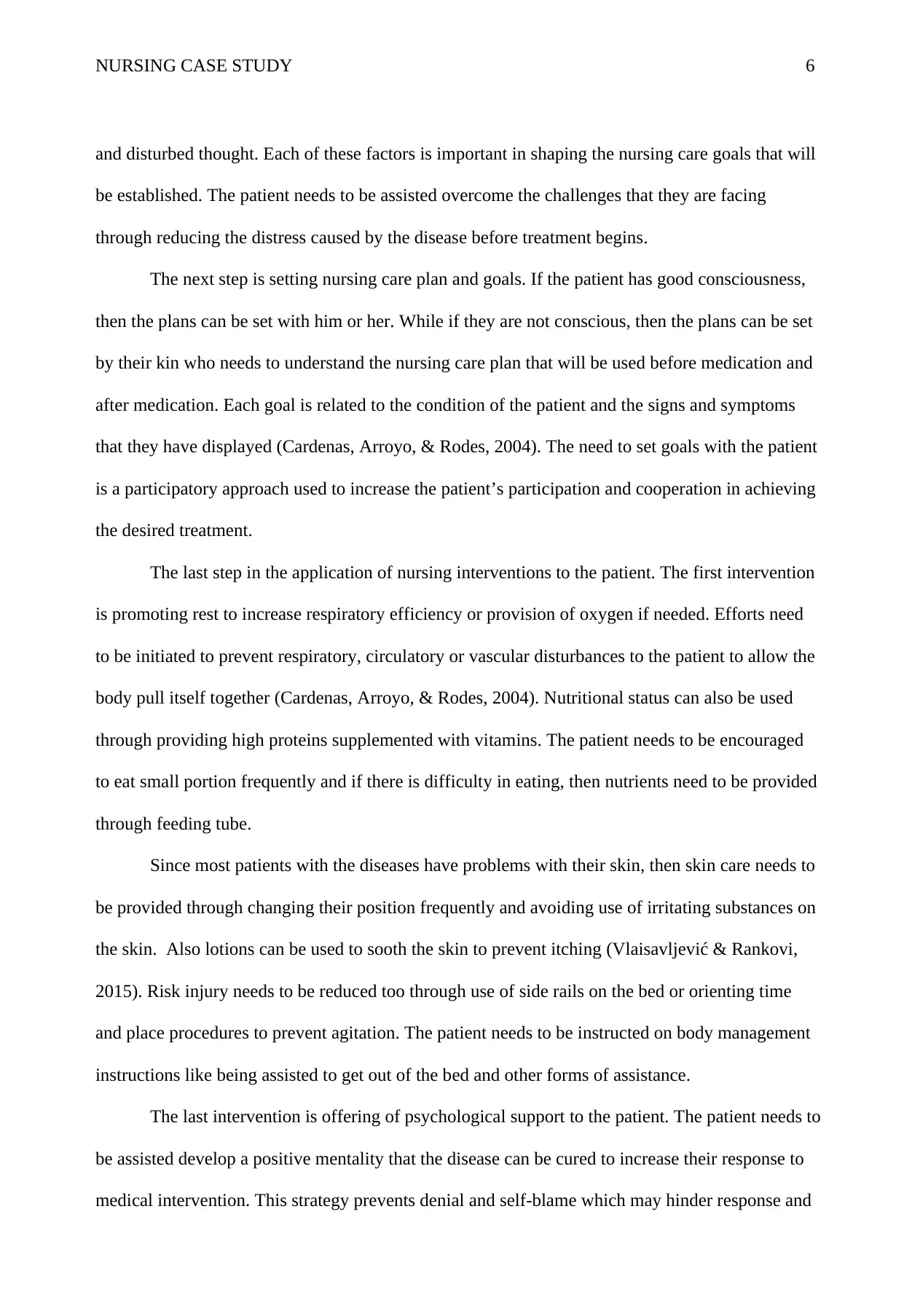
NURSING CASE STUDY 6
and disturbed thought. Each of these factors is important in shaping the nursing care goals that will
be established. The patient needs to be assisted overcome the challenges that they are facing
through reducing the distress caused by the disease before treatment begins.
The next step is setting nursing care plan and goals. If the patient has good consciousness,
then the plans can be set with him or her. While if they are not conscious, then the plans can be set
by their kin who needs to understand the nursing care plan that will be used before medication and
after medication. Each goal is related to the condition of the patient and the signs and symptoms
that they have displayed (Cardenas, Arroyo, & Rodes, 2004). The need to set goals with the patient
is a participatory approach used to increase the patient’s participation and cooperation in achieving
the desired treatment.
The last step in the application of nursing interventions to the patient. The first intervention
is promoting rest to increase respiratory efficiency or provision of oxygen if needed. Efforts need
to be initiated to prevent respiratory, circulatory or vascular disturbances to the patient to allow the
body pull itself together (Cardenas, Arroyo, & Rodes, 2004). Nutritional status can also be used
through providing high proteins supplemented with vitamins. The patient needs to be encouraged
to eat small portion frequently and if there is difficulty in eating, then nutrients need to be provided
through feeding tube.
Since most patients with the diseases have problems with their skin, then skin care needs to
be provided through changing their position frequently and avoiding use of irritating substances on
the skin. Also lotions can be used to sooth the skin to prevent itching (Vlaisavljević & Rankovi,
2015). Risk injury needs to be reduced too through use of side rails on the bed or orienting time
and place procedures to prevent agitation. The patient needs to be instructed on body management
instructions like being assisted to get out of the bed and other forms of assistance.
The last intervention is offering of psychological support to the patient. The patient needs to
be assisted develop a positive mentality that the disease can be cured to increase their response to
medical intervention. This strategy prevents denial and self-blame which may hinder response and
and disturbed thought. Each of these factors is important in shaping the nursing care goals that will
be established. The patient needs to be assisted overcome the challenges that they are facing
through reducing the distress caused by the disease before treatment begins.
The next step is setting nursing care plan and goals. If the patient has good consciousness,
then the plans can be set with him or her. While if they are not conscious, then the plans can be set
by their kin who needs to understand the nursing care plan that will be used before medication and
after medication. Each goal is related to the condition of the patient and the signs and symptoms
that they have displayed (Cardenas, Arroyo, & Rodes, 2004). The need to set goals with the patient
is a participatory approach used to increase the patient’s participation and cooperation in achieving
the desired treatment.
The last step in the application of nursing interventions to the patient. The first intervention
is promoting rest to increase respiratory efficiency or provision of oxygen if needed. Efforts need
to be initiated to prevent respiratory, circulatory or vascular disturbances to the patient to allow the
body pull itself together (Cardenas, Arroyo, & Rodes, 2004). Nutritional status can also be used
through providing high proteins supplemented with vitamins. The patient needs to be encouraged
to eat small portion frequently and if there is difficulty in eating, then nutrients need to be provided
through feeding tube.
Since most patients with the diseases have problems with their skin, then skin care needs to
be provided through changing their position frequently and avoiding use of irritating substances on
the skin. Also lotions can be used to sooth the skin to prevent itching (Vlaisavljević & Rankovi,
2015). Risk injury needs to be reduced too through use of side rails on the bed or orienting time
and place procedures to prevent agitation. The patient needs to be instructed on body management
instructions like being assisted to get out of the bed and other forms of assistance.
The last intervention is offering of psychological support to the patient. The patient needs to
be assisted develop a positive mentality that the disease can be cured to increase their response to
medical intervention. This strategy prevents denial and self-blame which may hinder response and
⊘ This is a preview!⊘
Do you want full access?
Subscribe today to unlock all pages.

Trusted by 1+ million students worldwide
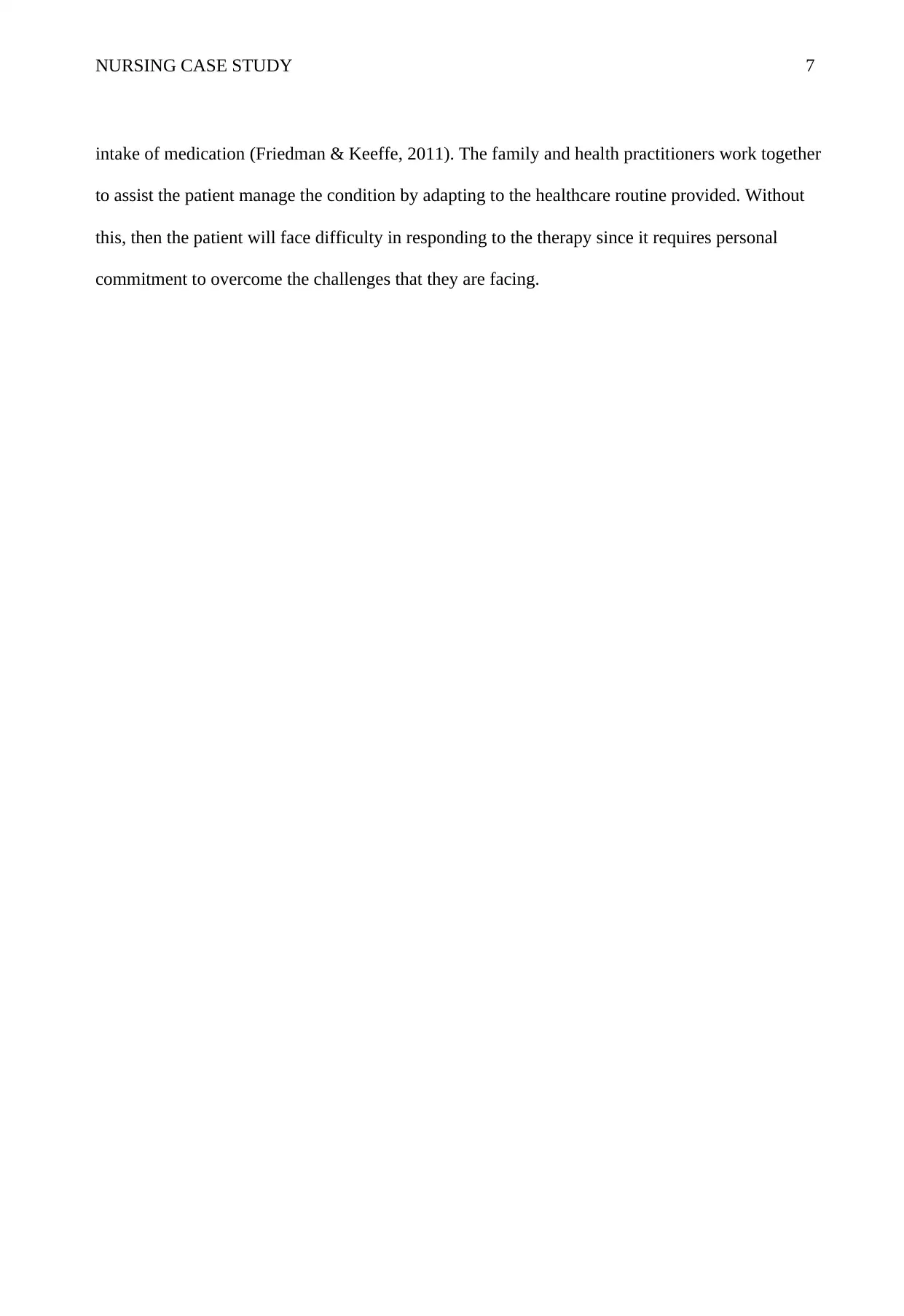
NURSING CASE STUDY 7
intake of medication (Friedman & Keeffe, 2011). The family and health practitioners work together
to assist the patient manage the condition by adapting to the healthcare routine provided. Without
this, then the patient will face difficulty in responding to the therapy since it requires personal
commitment to overcome the challenges that they are facing.
intake of medication (Friedman & Keeffe, 2011). The family and health practitioners work together
to assist the patient manage the condition by adapting to the healthcare routine provided. Without
this, then the patient will face difficulty in responding to the therapy since it requires personal
commitment to overcome the challenges that they are facing.
Paraphrase This Document
Need a fresh take? Get an instant paraphrase of this document with our AI Paraphraser
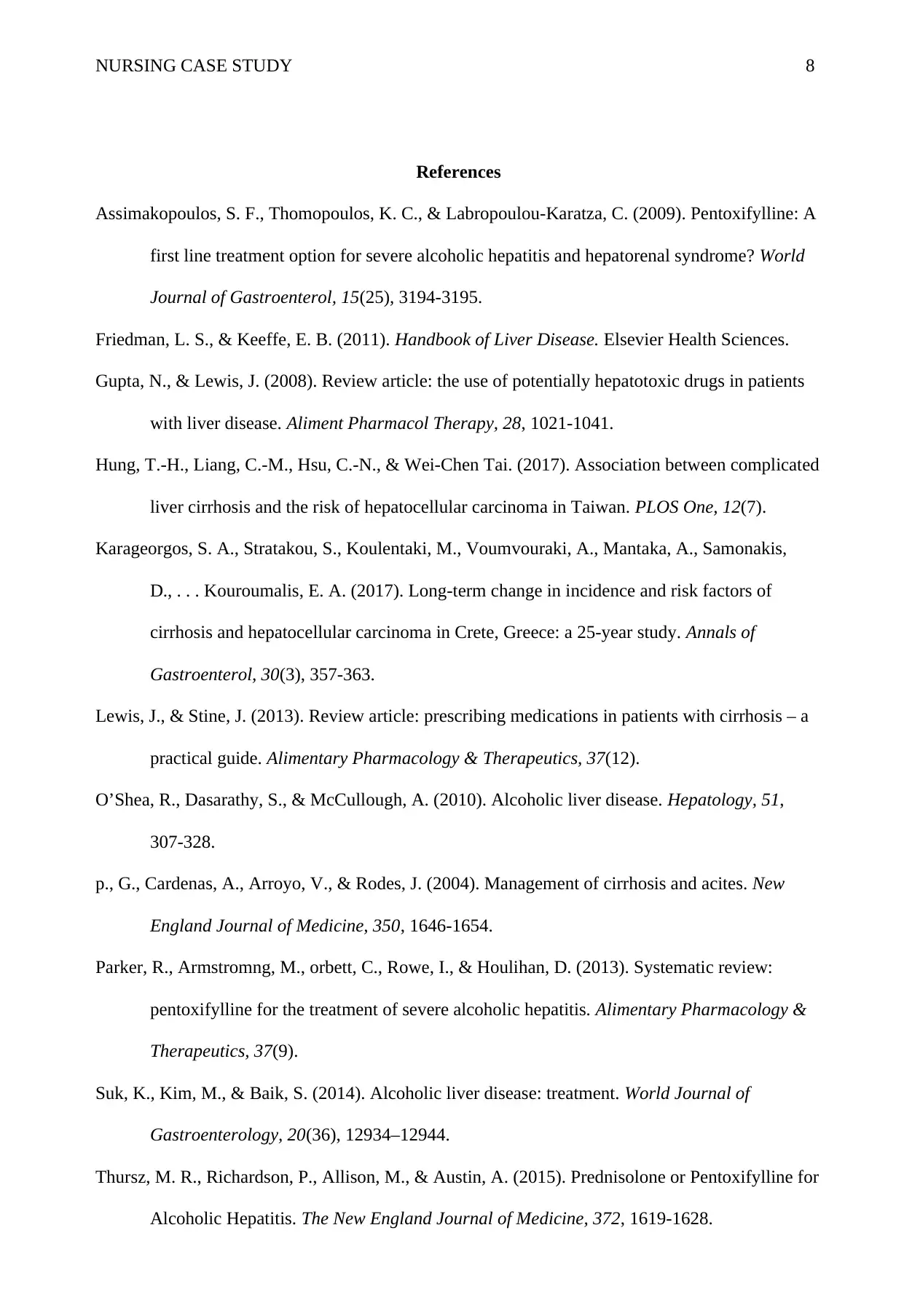
NURSING CASE STUDY 8
References
Assimakopoulos, S. F., Thomopoulos, K. C., & Labropoulou-Karatza, C. (2009). Pentoxifylline: A
first line treatment option for severe alcoholic hepatitis and hepatorenal syndrome? World
Journal of Gastroenterol, 15(25), 3194-3195.
Friedman, L. S., & Keeffe, E. B. (2011). Handbook of Liver Disease. Elsevier Health Sciences.
Gupta, N., & Lewis, J. (2008). Review article: the use of potentially hepatotoxic drugs in patients
with liver disease. Aliment Pharmacol Therapy, 28, 1021-1041.
Hung, T.-H., Liang, C.-M., Hsu, C.-N., & Wei-Chen Tai. (2017). Association between complicated
liver cirrhosis and the risk of hepatocellular carcinoma in Taiwan. PLOS One, 12(7).
Karageorgos, S. A., Stratakou, S., Koulentaki, M., Voumvouraki, A., Mantaka, A., Samonakis,
D., . . . Kouroumalis, E. A. (2017). Long-term change in incidence and risk factors of
cirrhosis and hepatocellular carcinoma in Crete, Greece: a 25-year study. Annals of
Gastroenterol, 30(3), 357-363.
Lewis, J., & Stine, J. (2013). Review article: prescribing medications in patients with cirrhosis – a
practical guide. Alimentary Pharmacology & Therapeutics, 37(12).
O’Shea, R., Dasarathy, S., & McCullough, A. (2010). Alcoholic liver disease. Hepatology, 51,
307-328.
p., G., Cardenas, A., Arroyo, V., & Rodes, J. (2004). Management of cirrhosis and acites. New
England Journal of Medicine, 350, 1646-1654.
Parker, R., Armstromng, M., orbett, C., Rowe, I., & Houlihan, D. (2013). Systematic review:
pentoxifylline for the treatment of severe alcoholic hepatitis. Alimentary Pharmacology &
Therapeutics, 37(9).
Suk, K., Kim, M., & Baik, S. (2014). Alcoholic liver disease: treatment. World Journal of
Gastroenterology, 20(36), 12934–12944.
Thursz, M. R., Richardson, P., Allison, M., & Austin, A. (2015). Prednisolone or Pentoxifylline for
Alcoholic Hepatitis. The New England Journal of Medicine, 372, 1619-1628.
References
Assimakopoulos, S. F., Thomopoulos, K. C., & Labropoulou-Karatza, C. (2009). Pentoxifylline: A
first line treatment option for severe alcoholic hepatitis and hepatorenal syndrome? World
Journal of Gastroenterol, 15(25), 3194-3195.
Friedman, L. S., & Keeffe, E. B. (2011). Handbook of Liver Disease. Elsevier Health Sciences.
Gupta, N., & Lewis, J. (2008). Review article: the use of potentially hepatotoxic drugs in patients
with liver disease. Aliment Pharmacol Therapy, 28, 1021-1041.
Hung, T.-H., Liang, C.-M., Hsu, C.-N., & Wei-Chen Tai. (2017). Association between complicated
liver cirrhosis and the risk of hepatocellular carcinoma in Taiwan. PLOS One, 12(7).
Karageorgos, S. A., Stratakou, S., Koulentaki, M., Voumvouraki, A., Mantaka, A., Samonakis,
D., . . . Kouroumalis, E. A. (2017). Long-term change in incidence and risk factors of
cirrhosis and hepatocellular carcinoma in Crete, Greece: a 25-year study. Annals of
Gastroenterol, 30(3), 357-363.
Lewis, J., & Stine, J. (2013). Review article: prescribing medications in patients with cirrhosis – a
practical guide. Alimentary Pharmacology & Therapeutics, 37(12).
O’Shea, R., Dasarathy, S., & McCullough, A. (2010). Alcoholic liver disease. Hepatology, 51,
307-328.
p., G., Cardenas, A., Arroyo, V., & Rodes, J. (2004). Management of cirrhosis and acites. New
England Journal of Medicine, 350, 1646-1654.
Parker, R., Armstromng, M., orbett, C., Rowe, I., & Houlihan, D. (2013). Systematic review:
pentoxifylline for the treatment of severe alcoholic hepatitis. Alimentary Pharmacology &
Therapeutics, 37(9).
Suk, K., Kim, M., & Baik, S. (2014). Alcoholic liver disease: treatment. World Journal of
Gastroenterology, 20(36), 12934–12944.
Thursz, M. R., Richardson, P., Allison, M., & Austin, A. (2015). Prednisolone or Pentoxifylline for
Alcoholic Hepatitis. The New England Journal of Medicine, 372, 1619-1628.
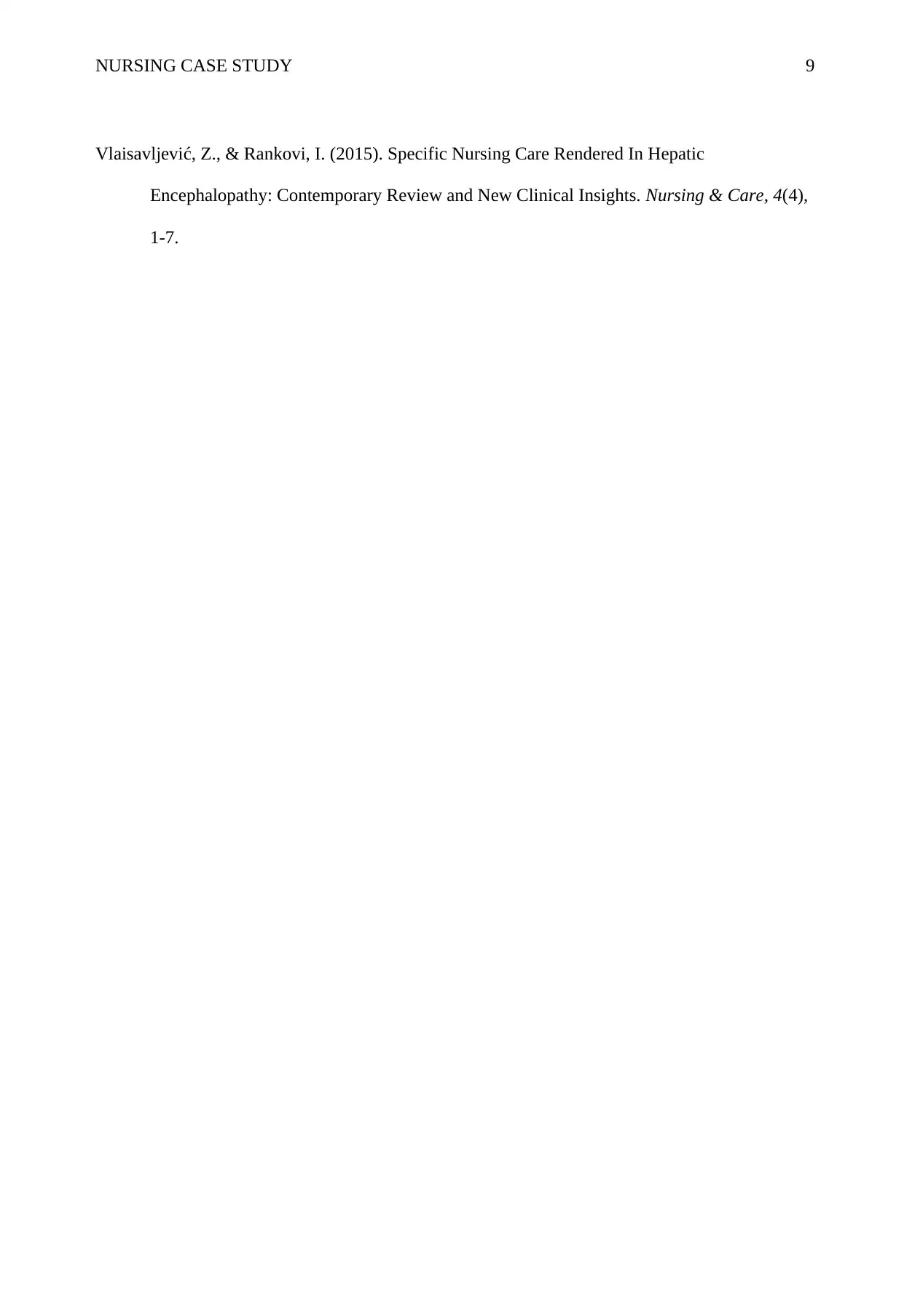
NURSING CASE STUDY 9
Vlaisavljević, Z., & Rankovi, I. (2015). Specific Nursing Care Rendered In Hepatic
Encephalopathy: Contemporary Review and New Clinical Insights. Nursing & Care, 4(4),
1-7.
Vlaisavljević, Z., & Rankovi, I. (2015). Specific Nursing Care Rendered In Hepatic
Encephalopathy: Contemporary Review and New Clinical Insights. Nursing & Care, 4(4),
1-7.
⊘ This is a preview!⊘
Do you want full access?
Subscribe today to unlock all pages.

Trusted by 1+ million students worldwide
1 out of 9
Related Documents
Your All-in-One AI-Powered Toolkit for Academic Success.
+13062052269
info@desklib.com
Available 24*7 on WhatsApp / Email
![[object Object]](/_next/static/media/star-bottom.7253800d.svg)
Unlock your academic potential
Copyright © 2020–2025 A2Z Services. All Rights Reserved. Developed and managed by ZUCOL.





